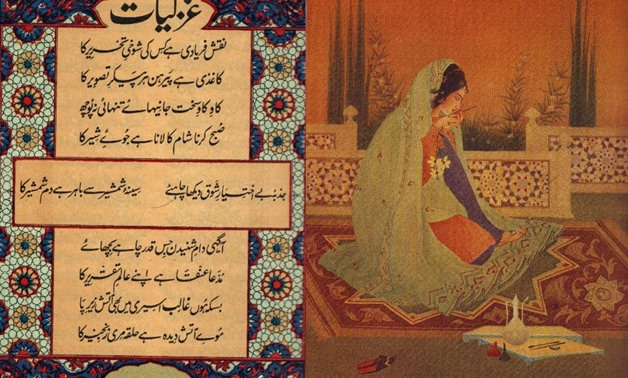
Diwan-e-Ghalib_Muraq-e-Chugtai, 1927
CAIRO – 17 September 2017: People always have a number of stereotypical images in their minds based on the media.
Pakistan carries the image of a poor, dangerous country and that has negatively affected the image of their culture; the truth is, Pakistan has a number of talented painters and artists who managed to establish a unique contemporary art scene.
Mainly, Pakistani contemporary art is a getaway from the social and political issues related to reality. It aims to create another metaphorical world; a world that knows no time or place, and is also interested in mythology.
The history of Pakistani contemporary art witnessed a number of outstanding names; Abdur Rahman Chaugtia is the first Indian Muslim artist; he was taught in Pakistan. He had a long and productive career especially connected to Urdu literature, and his paintings were based on Islamic and Mughal aesthetics and ideas.
Chaugtia’s early works were characterized by simple architectural frames, outdoor locations, and featuring Urdu mythological figures, while his later works were more complex.
Despite the importance of Chaugtia’s efforts, Pakistan needed more revolutionary thoughts. Constructing strong foundations for arts teaching was an important step in the history of Pakistani arts.
In 1958, the Mayo School of Arts was upgraded to the National College of Arts, and it focused more on teaching the modern arts.
The Punjab University had a specialized department of Fine Arts which was headed by the expressionist artist Anna Molka Ahmed who organized numerous exhibits.
Another artist is Zainul Abedin who founded the institute of Fine Arts in Dakhla.
Zainul Abedin is one of the outstanding artists in the history of Pakistani arts before the independence of Bangladesh. His first popular works were about the famine in Bengal.
He focused more on excremental art and folk art. He did not focus his work on Islamic principles, but he focused on portraying humans and animals in a heroic shape.
Regarding the feminine powers in the journey of Pakistani art, it is important to mention Zubeida Agha who made a number of exhibits and wanted to initiate a movement of international contemporary arts in Pakistan.
She was influenced by both the Greek philosophy and the western culture, and these diverse influences created richness in her paintings.
Another important artist who contributed to developing the dynamic language of colors is Ahmed Parvez.
After that the Pakistani modern arts were influenced by a number of political issues, which led to a number of artists carrying certain political beliefs, such as Shakir Ali, who depended on symbolism and imagination.
During the 1960s and 1970s, the art of calligraphy witnessed a new rise by Hanif Ramay, Iqpal Geoffrey, Anwar Jalal Shemza and Sadequain.
Then seeking to shed more light on political and social issues, a number of artists wanted to raise people's awareness about social concerns especially through sculpture and photography.
It is worth mentioning that the efforts of Arif Mahmood, Nashmia Haroon, Sajjad Ahmed and others contributed to the expansion of the media used in arts as they introduced videos.
The contemporary arts scene witnessed different changes with the rise of the Islamic politics, the existence of feminism, the restoration of unstable democracy, globalization, and economic radical changes.
At this stage, a major contribution to the growth of contemporary arts was provided through the students and teachers of NCA; where a new generation of artists were raised, such as Waseem Ahmed, Khadim Ali, Warddha Shabbir and Muhammed Zeeshan. Their works carried repeated floral motifs, using vasli papers and sculpture.
Another change brought by NCA artists was spreading the contemporary arts into the minor cities not only the major ones.
The variety of artistic schools created a competitive environment which positively affected the development of contemporary arts; the works of Beaconhouse National University (BNU) students employed innovative conceptual strategies and digital influences, while Indus Valley School of Art and Architecture (IVS) students focused on complex materials and structures. The differences enriched the content and widened the range of creativity.
Many artists preferred to combine traditional mediums with innovative material in sculpture such as Akram Dost Balosh, while Kiran Saleem and Inaam Zafar created expressionist, figurative and narrative moods in painting and printing.
After the September 11 events, the scene in Pakistan was negatively affected, as it only focused on one dimensional works that expressed terrorism and violence.
Due to globalization, the arts included themes such as “the home” and “the Diaspora” especially through Pakistani artists who lived abroad like Bani Abidi.
Recently, contemporary arts became a main platform for criticizing society through making site-specific interventions.
The Pakistani contemporary arts scene is rich, and follows international artistic transformations.

Comments
Leave a Comment